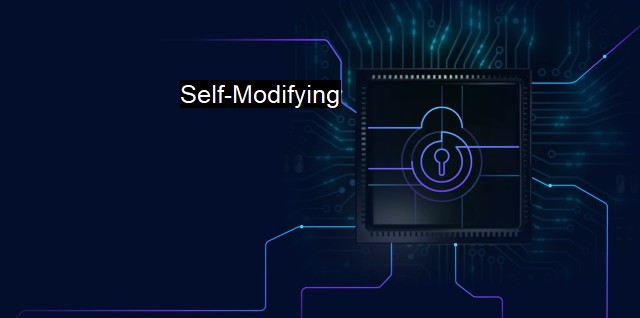What is Self-Modifying?
Exploring the Advancements in Cybersecurity with Self-Modifying Antivirus Technology"
The term "Self-Modifying" represents a concept interlinked with advanced and sophisticated malware techniques. This process involves the alteration of an existing code structure to discreetly mask its presence or enhance its malicious capabilities, which further challenges cybersecurity strategies, necessitates more formidable defense systems, and demands an intensive understanding of this new paradigm.The characteristic ability of self-modification used by a specific variety of malware allows it to dynamically evolve its code, switch its characteristics, or alter its behavior patterns in a significant way. The primary goal here is to prevent identification, to bypass detection techniques, and successfully infiltrate target systems without being flagged by installed antivirus software. Consider it as a chameleon that constantly alters its appearance to bypass predators.
Malware authors conceive self-modifying code as a tactic for dealing with heuristic analysis, a prevalent methodology utilized by most modern antivirus software. Heuristic analysis is designed to identify malicious code by comparing the behavioral pattern or characteristics of a file or program with known malware signatures. By repetitively mutating itself, malware makes it incredibly challenging for heuristic scanners to flag them, as the underlying code structure would not match typical preidentified malicious code structures.
The two main variations within the family of self-modifying malware are polymorphic and metamorphic. These terms denote malware that varies by design or structure and malware that alter their code altogether, respectively.
Polymorphic malware calls on complex algorithms to alter their code and encrypt the payload, all the while keeping the same algorithmic logic, making each derivative unique and harder to detect. The payload, typically the primary driver of the damage, remains encrypted until the malware lands in the unsuspecting system, making it almost impossible even for advanced scanners to detect and prevent its infiltration.
Meanwhile, metamorphic malware takes a step further, implementing a more multifaceted technique called code obfuscation. This approach involves iterating the malware code base, results in the generation of entirely new versions that may perform the same action but look and behave differently. This property allows the metamorphic malware to blend even better and stay undetected inside diverse systems and infrastructural setups.
While self-modifying malware poses a considerable threat to cybersecurity, researchers and antivirus developers are putting forward resourceful means to counter this menace. Generic signature detection, behavior blocking, static analysis, sandbox detection, threat emulation are among the various technologically advanced mitigation strategies pursued by specialists in the field.
Generic signature detection banks on diminishing the favorability of small, trivial mutations by creating a broad virus signature, preferably targeting common sections in code of various malware derivatives. Behavior blocking detects and isolates processes displaying suspicious behavior that deviates from expected system norms, while static analysis investigates the characteristics of unexecuted code, raising flags when the code is found to possess bit-shifting characteristics.
Sandbox detection provides a secure, isolated environment—one could refer to it as a sort of decoy system—where files are allowed to execute and their behaviors captured and scrutinized. Lastly, threat emulation decrypts each observed piece of malware in a safe environment, hermetically sealed off from actual systems to evaluate potential harm before it can infiltrate the checked systems.
Though more sophisticated and challenging, the self-modifying approach raises the bar in the ever-evolving cat-and-mouse game between cybercriminals and cybersecurity specialists. Nonetheless, progressive advancements in antivirus technology coupled with the increasing dive into artificial intelligence-based predictive modelling are aiding cybersecurity systems in outsmarting this contemporary menace, providing us greater immunity, assurance, and potency in protecting our digital world.

Self-Modifying FAQs
What is self-modifying code in the context of cybersecurity and antivirus?
Self-modifying code is a type of code that can alter its behavior or structure during runtime. This means that the code can change its own instructions, making it difficult for antivirus software to detect malicious behavior.Why is self-modifying code a challenge for antivirus software?
Self-modifying code is a challenge for antivirus software because it can evade detection by constantly changing its own instructions. This makes it difficult for antivirus software to keep up and identify the code as malicious.How do cybersecurity professionals address the issue of self-modifying code?
Cybersecurity professionals address the issue of self-modifying code by using advanced detection techniques, such as behavioral analysis and heuristics, to identify potentially malicious behavior. They also rely on continuous monitoring and updating of antivirus software to keep up with the ever-changing nature of self-modifying code.What are some examples of malware that use self-modifying code?
Some examples of malware that use self-modifying code include polymorphic viruses, metamorphic viruses, and file infectors. These types of malware can change their own code to avoid detection and spread to other systems.Related Topics
Malware Polymorphic malware Metamorphic malware Code obfuscation Application whitelisting
| | A | | | B | | | C | | | D | | | E | | | F | | | G | | | H | | | I | | | J | | | K | | | L | | | M | |
| | N | | | O | | | P | | | Q | | | R | | | S | | | T | | | U | | | V | | | W | | | X | | | Y | | | Z | |
| | 1 | | | 2 | | | 3 | | | 4 | | | 7 | | | 8 | | |||||||